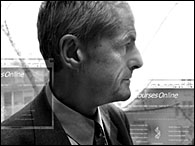The COOLest of courses
David Harpp is a visual guy. The Macdonald Professor of Chemistry has a long-standing interest in using visual materials to help drive home scientific ideas. "In the '60s it was slides," recalls the man who amassed 180 trays worth of lecture-related images, which he employed in a two-slide lap-dissolve technique to create a low-tech form of in-class animation. (There was even a time when each of Harpp's 500-odd students received a rather nifty handheld filmstrip viewer - each semester, Harpp and his helpers manually sliced two kilometres of film to create the strips.) Lap-dissolves were a fixture in Harpp's classroom until as recently as two-and-a-half years ago, but times change. "The slide tray has become the slide rule of the year 2002," Harpp admits. "We don't know what to do with them. It's an interesting problem which materialized almost overnight."
 Professor David Harpp
Professor David HarppPHOTO: Claudio Calligaris |
|
Enter COursesOnLine, aka COOL.
In the fall of 1997, then-undergrad Nic Siggel noted Harpp's visual orientation and approached him about ramping up the technology. Within the year, summer students were hard at work digitizing 10,000-plus slides for use in PowerPoint, including those of colleagues Ariel Fenster and Joe Schwarcz. Shortly after, a group of undergrads (led by William Hsiao, Nat Goodyer and Jason Parente) began working out the technical details of making those PowerPoint lectures available online. By fall 2000, COOL was up and running.
COOL differs from WebCT in that it doesn't merely offer lecture notes - it offers the actual lectures themselves, just as they appeared in the classroom. The lecturer doesn't appear (Harpp and his COOL peers deemed the talking-head approach "too distracting"); instead, students are given the lecture's audio track, perfectly synchronized with the corresponding 100 to 200 slide images. All of this is achieved with almost no post-production and at a negligible cost. All the instructors need do is plug a microphone into the laptop, then give their PowerPoint lecture as usual. Afterward, cleverly re-jigged freeware combines the new sound file with the existing PowerPoint file. Within fifteen minutes of completing an "in-person" lecture, the instructor can already have uploaded its virtual equivalent.
Best of all - unlike the original lectures - students can revisit these virtual lectures as many times as they wish: at 5:17 a.m... the night before an exam... while wearing fuzzy pajamas (or not). It's all about increasing options.
"It's a way of making the students more independent," notes Harpp. If they've missed a lecture, students can now pick it up online. If they attended a lecture on a particularly vexing topic, they can review it at their own pace. (Harpp notes that site hits exhibit "an asymptotic increase before midterms.") And if a student would rather not leave her apartment except to get cash for the pizza guy, she can watch an entire semester's worth of lectures from the comfort of her couch - not that Harpp necessarily condones such antisocial behaviour.
"The traditional lecture's not going away," he insists. "We have an all-star cast of profs, and COOL is just one more tool that just adds to their lectures. Personally, I see this as a supplement, an add-on, an extra - and, in a pinch, a way to do a course - and we tell students not to use it as a substitute for attending lectures."
That said, Harpp admits "there's no question attendance has slipped." (Then again, 100% attendance throughout the semester is basically an impossibility to begin with, COOL or no.) He reports that almost all the students use the system (to varying degrees) in conjunction with regular attendance, with only between five and 10 percent preferring to absorb all their lectures as virtual hermits.
Although student enthusiasm for COOL is extremely strong (5,000 hits per week isn't uncommon around exams), Harpp is amused by the matter-of-fact manner in which they have embraced the technology. He recalls the early days of the program, when he was recording lectures for web retrieval, but students were yet to be informed of the site's existence. A student told Harpp that she had been unable to attend the first three classes and was now looking to borrow lecture notes. Delighted at having an unsuspecting guinea pig, Harpp gleefully told the student that the actual lectures were available online. "I was hoping she would say, 'Wow! That's unbelievable!'," he says, laughing. "Instead she just said, 'OK. Thanks.'
"I call it the Harry Potter effect," he adds. "Students these days expect these technological advances. Thirty years ago, they would have been bananas over this. Now, they certainly appreciate it, but they're not as flabbergasted."
Presently, COOL carries lectures for General Chemistry, Organic Chemistry, Physical Chemistry, the four World of Chemistry courses and a Pathology course - nearly 3,000 students in all. (Site access, however, isn't restricted to students enrolled in these courses; anyone with a broadband connection is welcome to check it out.) The future will likely see the site expand to include other "factoid courses" (which best lend themselves to the online lecture format), and Harpp proudly notes that several universities have expressed interest in following in McGill's footsteps.
"I'd like to think that a traditional, in-person lecture provides motivation and inspiration," Harpp adds. "You get a feeling for people's personalities. When you have a bad lecturer, it's a nightmare - but a great lecturer really makes a subject come alive. Is an online lecture better than a traditional lecture? The answer is: It's a system that gives students more flexibility.
"So it isn't better - but it's still darn good!"
Check out cool.mcgill.ca to see all the on-line courses and lecture line-ups taught by professors Bruce Arndtsen, Karine Auclair, Chris Barrett, Masad Damha, Ariel Fenster, David Harpp, Joe Schwarcz, Paul Wiseman and Edith Zorychta. Please contact Prof. Harpp at 398-6685 or david.harpp@mcgill.ca for further info.

